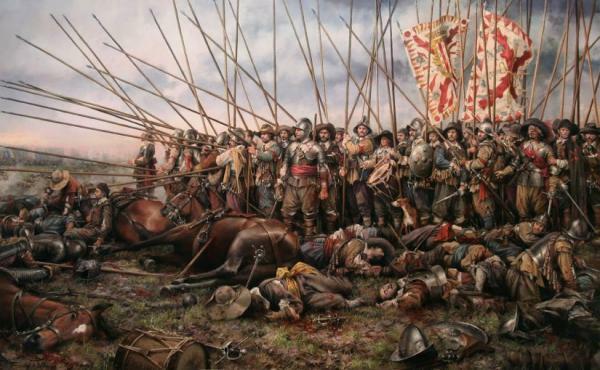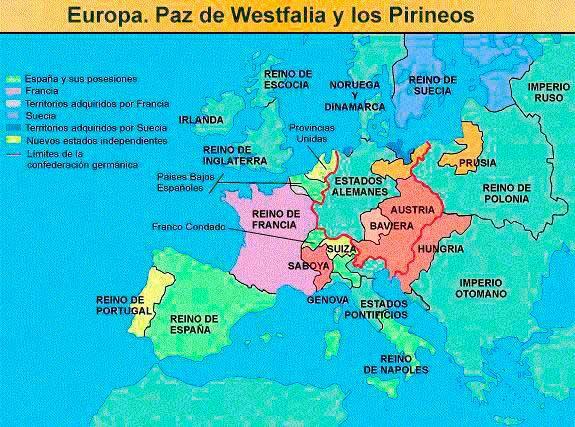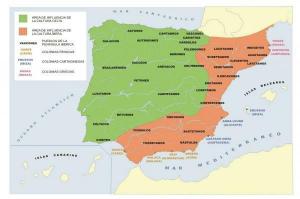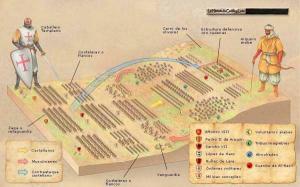30 years war

Throughout history different events occur that cause a total change in the times where they happen. Many of these events are warlike, being the consequences of these wars the ones that change the map and affect the events that occurred in subsequent years. One of the most important wars in history is that of the 30 years, whose consequences changed Europe forever. For all this, in this lesson from a TEACHER we are going to offer you a summary of the 30 years war so that you know better this warlike confrontation.
The 30 Years War was a war fought in Europe between 1618 and 1648, in which all the major European countries participated. Like all wars, the reasons that caused it in the first instance were evolving, being at first caused by religion and the existing break between the reform and counter-reformbut changing these once other countries entered whose motivations were different.
Background to the 30 Years War
To talk about the causes of the 30 Years' War we must give a little context of the pre-conflict era. In the 16th century, Carlos I of Spain had signed a treaty called
the Peace of Augsburg, with the German princes, seeking peace between Lutherans and Catholics. But this treaty was very weak, and the tensions between both sides did not stop increasing.Years later the grandson of Carlos, Felipe III of Spain, and the King of France, began to be interested in the German territories. The first for having dominions in the area, and the second for their quest to regain the power lost in previous decades.
Meanwhile in the Holy German Empire there was great tension between Protestants and Catholics and it was only a matter of time before they would face each other. At the time that Ferdinand II, a Catholic leader, was appointed German Emperor and King of Bohemia, with the idea of imposing religion on him, he caused the Protestant uprisings of Bohemia.
The 4 causes of the 30 Years War
For all this we can talk about the many causes that caused this important conflict. The main causes are the following:
- In principle it was a religious war, which pitted Catholics against Protestants. The tension between the two groups is one of the main causes.
- The appointment of Ferdinand II, a great defender of Catholics, caused the revolts that started the war.
- Some countries joined the war when they saw the occasion to take possessions that would increase their hegemony, being the case of those states that did not have so many religious problems.
- The war zone was very commercially important and many states wanted to dominate it, this being the reason why countries of the same religion clashed with each other during the conflict.

Image: QueAprendemosHoy.com
To continue with this summary of the 30 Years War we must talk about its development. It was a very broad conflict, so the war is usually divided into 4 phases, to better understand how it evolved. These 4 phases are as follows:
Bohemian phase
The election of Ferdinand II as King of Bohemia caused a great revolt of Protestants throughout the area, which took a couple of years to be stopped. What in principle was only an internal conflict reached other countries, this revolt being the one that started the 30-year war.
In this phase, one of the moments of greatest tension between the two religions occurred, the so-called Third defenestration of Prague. In this event a series of Protestants kidnapped two king officials and threw them out of a palace window, taking Prague and forming a government. After this they chose Frederick V as a person who should take the throne, being a direct attack on the true king, Fernando II.
Fernando chose as his general Von Tilly, who recovered numerous cities and reached Prague where he forced Frederick V to flee the city, and later razed the city of Prague. Fernando II returned to rule, prohibiting freedom of worship. It seemed that it was all over, but the war had already turned into an international conflict.
Danish phase
Fernando II had managed to take Bohemia and the Palatinate, two of the Protestant electors, leaving only two Protestant regions free. For this reason the election of the emperor was clearly turned towards the Catholic side, with the Protestants being in a large minority.
The Protestants were in the minority, so they asked for help from Christian IV, King of Denmark, who had an economic interest in entering a war with Germany. Cristian decided to attack Germany, but was defeated by Von Tilly, being forced to sign the Peace of Lubeck, according to which Denmark promised not to help the Protestant enemies of Ferdinand II. It did not take long for the emperor to take revenge on the leading German Protestants, forcing them to return the goods to the Catholic Church.
Swedish phase
Fernando II only got victories, but he had so many enemies that they never finished. The last to enter the war was Gustavo Adolfo, King of Sweden, who had been convinced by the French Minister Richelieu to attack Fernando.
The Swedish army was the best in the world, and it did not take long to achieve great victories against Germany. Much of the credit went to Gustavo Adolfo, a great warrior who fought on the front line of battle, which ended up costing him his life in one of the battles against the Germans.
The loss of Gustavo Adolfo was enormous for the Swedes, who ended up losing all the areas they had achieved. All of this ended up causing the Peace of Prague, which gave benefits to Ferdinand II, and was horrible for Swedish interests.
French phase
Richelieu had used Gustavo Adolfo to weaken the Germans, thereby making the French entry into the war much easier. The French minister got help from Saxony, the Netherlands and part of Italy, to confront the union formed by the Germans and the Spanish, both from the House of Habsburg.
For years there were numerous battles, but neither side seemed to get the upper hand. It was then that Ferdinand III he ascended the German throne, and Louis XIV he was named king of France, both with ideas closer to peace than his predecessors. Shortly after, and after a great victory by the French who managed to enter as far as Vienna, both sides signed peace, which was especially beneficial for the French.

Image: Schemes and concept maps of History
After the war, peace treaties were signed, which ended the conflict, and changed the future of Europe forever. These agreements were the Peace of Westphalia, signed in 1648, and the Peace of the Pyrenees, signed in 1658. Both agreements greatly weakened the Habsburgs, and strengthened the French, managing to change the hegemony of Europe, and causing a few years later the end of the Habsburgs.
Some of the consequences of these two treaties were the following:
- He increased the power of the nation-states against the Empire, since the emperor had to admit the power that the princes had in the states of him.
- Germany became a regime with total religious freedom, both Catholics and Protestants.
- France received important territories from both Spain and Germany.
- France increased its power to achieve European hegemony, while Spain became a minor state.
- The United Provinces they got their independence from Spain.
- The Pope lost much of power that he had in European politics.

Image: Universal History



